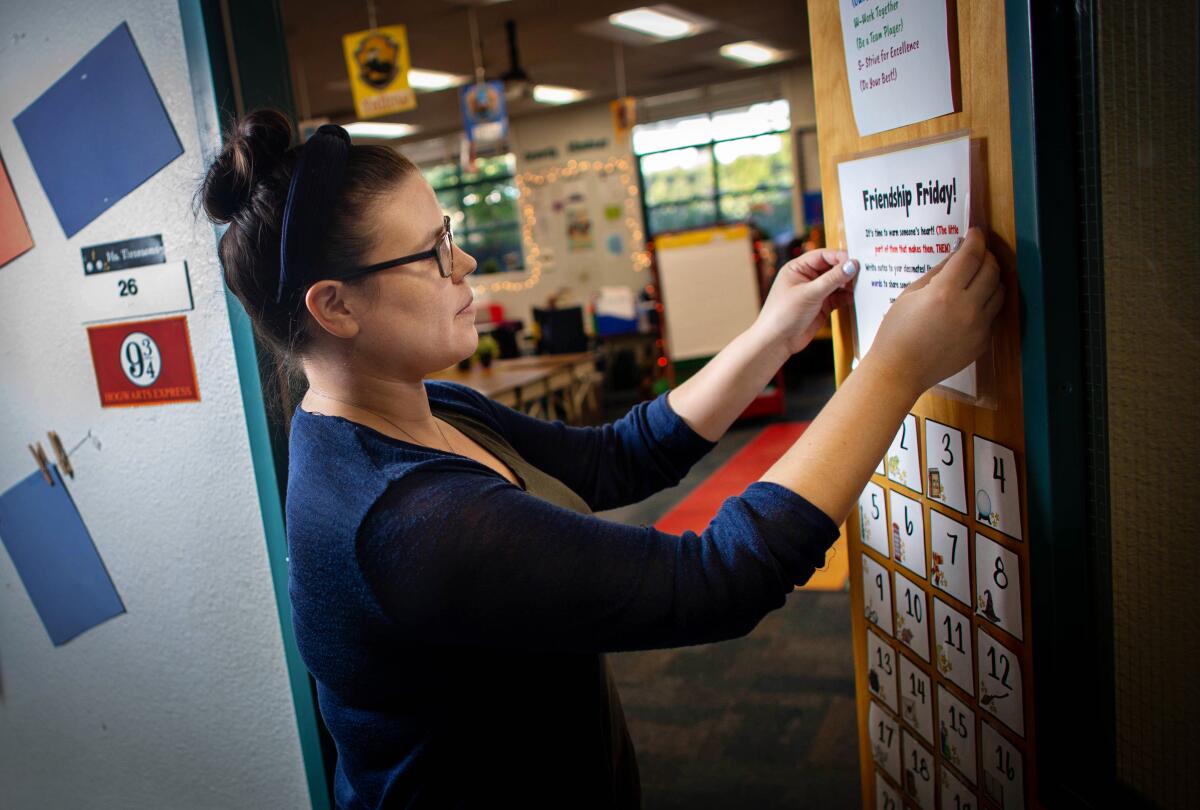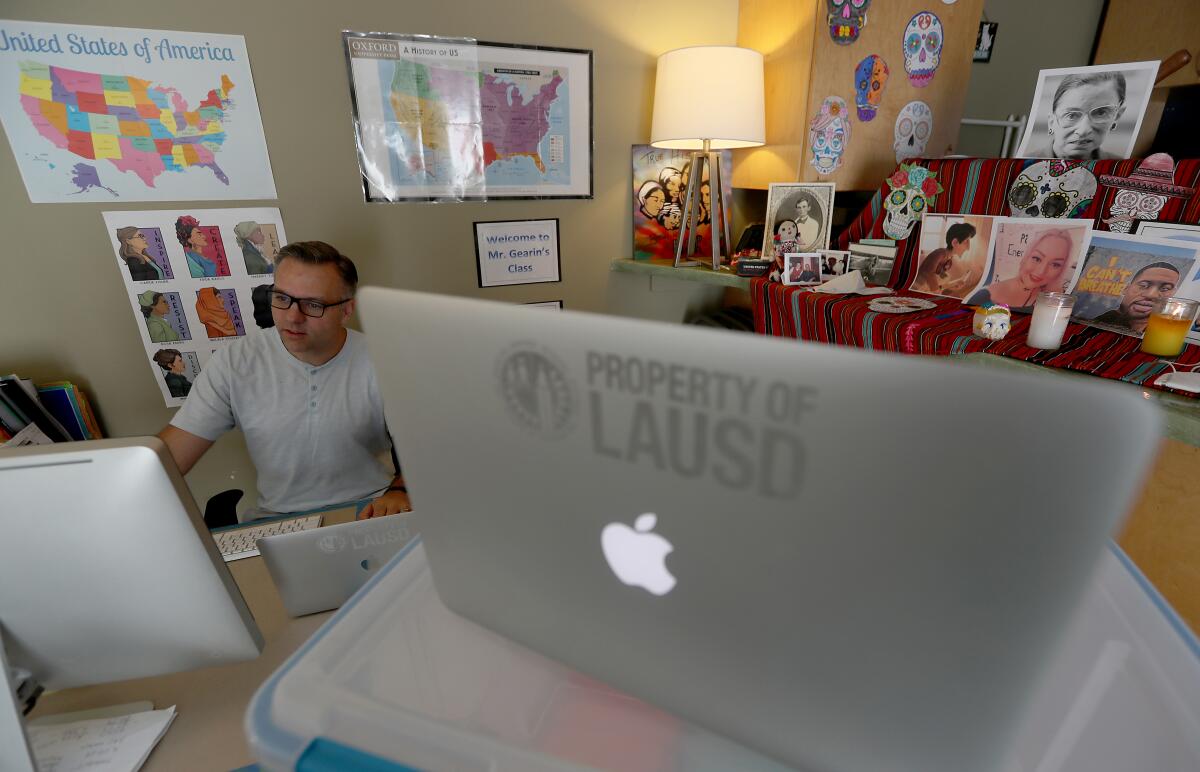Mid-semester, many L.A. students are drifting, beset with anxiety and struggling in class

- Share via
Every day, almost every one of Nicolle Fefferman’s students logs into her virtual classrooms at John Marshall High School in Los Feliz. A significant number do not turn their cameras on. Many don’t respond when she asks questions and don’t turn in work she assigns offline.
When the history teacher issued her 10-week progress reports, nearly one-third of her students were failing.
“I have almost 100% attendance. But that doesn’t necessarily mean 100% participation,” Fefferman said. “They’re showing up, but they’re not necessarily engaging.”
It’s midterm time, and inside their virtual classrooms teachers and students alike are being tested in ways that show the exhausting challenges teachers face working to keep drifting students engaged, the increasing anxiety and pressure many students are feeling and the stubborn remnants of the digital divide that continue to hobble learning. Interviews with a diversity of teachers throughout Los Angeles County offer detailed snapshots behind the individual computer screens of distance learning.
Throughout California the school year began with hopes that virtual schooling would be a vast improvement over the spring, when campuses suddenly closed and educators scrambled to shift online. In Los Angeles County, full school reopenings are probably months away as COVID-19 numbers languish in the state’s most restrictive “purple” Tier 1.
Teachers agree that important strides have been made to better reach and educate students from afar. Schedules are more rigorous and computers and hot spots are widely disbursed, efforts that have increased attendance. And many say they better understand how to use technology to their advantage. Teachers also say that in the face of adversity they are bonding with their students like never before.
Yet educators from Burbank to Wilmington say significant roadblocks remain. At the heart of their concerns, teachers find themselves struggling to balance their instinct to push students against their feelings of compassion, acknowledging their students’ unprecedented hardships.
“I’m struggling to be a good teacher, and it’s not a good feeling,” said Omar Ramírez, a history, economics and government teacher at Grant College Prep and Digital Arts Magnet High School in Van Nuys. “Things that I know work, that really get students excited, you can’t do. So I’m trying to figure out what I can do to make this distance learning thing work.”
Since the start of the new school year, Ramírez has used his advisory periods to better understand his students’ challenges. Usually, he starts class by asking them how they’re feeling. For weeks, they said fine. But last month, “it all poured out.”
Students described feeling exhausted, unable to unplug from school. Some said they were getting headaches from the screen time. After the live sessions, their dedication to their studies moves them to stay online working on assignments, sometimes for several hours.
Ramírez realized that he’s among the teachers assigning more homework than usual. His reason? He doesn’t want his students to fall behind. The pressure, he said, doesn’t come from administration. It’s because he’s meeting with students for less time and it takes longer to cover material.
“I think it’s a struggle a lot of teachers are feeling,” Ramírez said. “We’re meticulous, we plan every day, we plan out units. And we have kind of a feel for how long things are going to take…. That’s all out the window now.”
His students’ responses made him pause to consider the best way to move forward.
“When they shared that they feel that distance learning is hurting their grades, that kind of broke my heart a little bit. Because that shouldn’t be the case, you know?” he said. “It’s not their fault.”
Michael Gearin, an eighth-grade U.S. history teacher at Harry Bridges Span School in Wilmington, said many of his colleagues have expressed concern about being too easy on students during this time, worrying it might send the wrong message about not having to do their work.
But Gearin’s disposition is toward leniency. When he messages students who seem particularly withdrawn, many tell him of their lack of motivation; some say they’re feeling depressed. He has referred some to the school guidance counselor and is giving failing grades to just three of his 160 students this fall — those who haven’t turned in any work.
“I don’t think a report card filled with fails is going to snap them out of it,” Gearin said. “The way I say it to my colleagues is, ‘Have you ever taken six online classes at the same time when you’re 13 or 14?’ That’s what informs the kind of grace I’m giving students.”

Empathy for social-emotional needs
Sharonne Hapuarachy, who teaches English at Dorsey High School in Baldwin Hills, is constantly calling parents and tracking down students to ensure that they attend her classes. And that work has paid off. In the spring, about half of her students completely stopped logging on to class. This semester, about 25% of her 11th- and 12th-grade students don’t sign into class on any given day.
“Students who are consistently showing up are doing really well,” Hapuarachy said.
But more of them must work now to help support their families, and some have missed school because their family members were sickened by COVID-19. They tell her about their anxiety, decreased motivation and often feeling overwhelmed.
In a survey last month of 800 California parents from the research and advocacy group Education Trust-West, 67% of parents said their children were under more stress than usual.
During Hapuarachy’s biweekly advisory class, she has started incorporating lessons on mindfulness, deep breathing and meditation.
“I’ll ask them, ‘Is this helpful? Is it too weird?’ and they’ll tell me that they feel so much more calm and that they wish they could do it longer,” Hapuarachy said.
Christy Timmons, a second-grade teacher at Joaquin Miller Elementary School in Burbank, also said social-emotional check-ins have become crucial. She starts each day by asking her youngsters how they’re doing, and they give a thumbs-up or thumbs-down.
“I see some friends put their thumbs down,” she’ll say. “Anyone want to share what’s going on?”
Once that door is opened, more students begin talking about what’s making them sad; oftentimes they just miss their friends. “Who else misses their friends?” Timmons asks. More hands shoot up. Recently, many were upset that Halloween wouldn’t be the same this year.
“It’s so important to give them the validation that it’s OK to be sad, especially now,” Timmons said. “But also to remind them that no matter what, we’ll always have each other’s backs even though we’re not physically in a class.”
Zoom fatigue and internet woes
Many teachers also reported that after starting the school year highly committed and enthusiastic, some students are drifting — turning in fewer assignments or not signing in at all: “Zoom fatigue,” they said.
Timmons said she’s noticed that more cameras are off now compared with the start of the school year and that students are less likely to engage in small groups, Timmons’ main strategy for keeping them on their toes.
When all of her students are online together, they often “check out after five or 10 minutes, and I can see that they’re done,” Timmons said.
Melina Anthony, a kindergarten teacher at Fries Avenue Elementary in Wilmington, said she does more face-to-face time with her students than the 90 minutes required on most days because she believes students benefit from the live interaction.
Still, it’s a tough balance, and her students often become exhausted as the day wears on.
“A lot of them have tantrums after lunch. And you can see them, poor things, and you can see the parents trying to clear the air,” she said.
Across the county, teachers reported that lessons that would normally take one day now often take several days, in part because teachers have less time with their students. Many also said internet access remains a daily obstacle.
Gearin, the eighth-grade history teacher, said that nine weeks into the school year, his class was “really in week four or five.”
“I’m only meeting with them two or three times a week,” Gearin said. “It’s hard for me to gauge how much or little they’re learning compared to other years.”
Stephen Yardley, a second-grade teacher at 61st Street Elementary School in South L.A., said he often sees students raise their hands to ask a question and then suddenly disappear from the screen.
“I have students every day who lose a connection three, four or five times,” he said.
Statewide, the Public Policy Institute of California recently found that many families are still reporting difficulty with reliable access to the internet. The disparity is particularly stark among Latino and low-income students — more than 30% of Latino students still don’t have reliable internet access at home, along with nearly 40% of low-income students, according to the nonprofit think tank’s analysis of census data.
County officials have said that computers and hot spots are now in the hands of the vast majority of students. And Los Angeles Unified School District officials say they have enough computers and hot spots with sufficient bandwidth for every student who needs them.
Gearin said his students persevere despite the unreliable connections.
“The idea that they’re struggling to stay in the class and keep learning, yet keep coming back, is a testament to how much they want to be at school and doing well,” he said.
Times staff writer Howard Blume contributed to this report.
More to Read
Sign up for Essential California
The most important California stories and recommendations in your inbox every morning.
You may occasionally receive promotional content from the Los Angeles Times.













